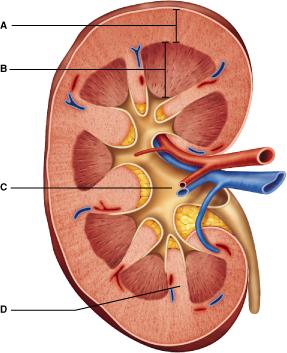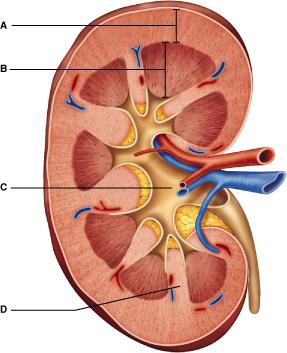
Which region of the kidney is characterized by the presence of cone-shaped pyramids? Select from letters A-D.
A
B
C
D
B

Which letter represents the most superficial region of the kidney? Select from letters A-D.
A
B
C
D
A
Which pressure is the chief force pushing water and solutes out of the blood and across the filtration membrane of the glomerulus?
hydrostatic pressure in glomerular capillaries
(HPgc)
colloid osmotic pressure in the capsular
space
hydrostatic pressure in the capsular space
(HPcs)
colloid osmotic pressure in glomerular capillaries (OPgc)
hydrostatic pressure in glomerular capillaries (HPgc)
Which of the three parts of the renal tubule is formed by cuboidal epithelial cells bordered by dense microvilli?
collecting duct
nephron loop
distal convoluted
tubule
proximal convoluted tubule
proximal convoluted tubule
The __________ collect(s) urine, which drains continuously from the
papillae; the urine is then emptied into the __________.
calyces;
renal pelvis
renal pyramids; renal pelvis
renal pelvis;
calyces
renal pyramids; calyces
calyces; renal pelvis
Each nephron contains a __________, which is a tuft of capillaries,
and a __________.
renal plexus and glomerular capsule;
glomerulus
glomerulus; renal tubule
renal plexus; renal
tubule
glomerulus; renal plexus
glomerulus; renal tubule
The renal corpuscle is made up of ________.
the renal
pyramid
Bowman's capsule and glomerulus
the renal
papilla
the descending loop of Henle
Bowman's capsule and glomerulus
The functional and structural unit of the kidneys is the
________.
glomerular capsule
capsular
space
nephron
nephron loop
nephron
Which cells of the kidney are chemoreceptors that respond to changes
in solute content of the filtrate?
mesangial
cells
juxtaglomerular cells
macula densa cells
podocytes
macula densa cells
Having a kinked ureter is called renal ptosis.
True
False
False
In what part of the renal tubule does parathyroid hormone (PTH) promote the reabsorption of calcium ions?
distal convoluted tubule (DCT)
collecting duct
proximal
convoluted tubule (PCT)
descending limb of the nephron loop
distal convoluted tubule (DCT)
Which statement best describes the effect diuretics have?
Diuretics increase water reabsorption as a way to decrease the
osmolality of the extracellular fluids.
Diuretics promote the
formation of the medullary gradient by acting on the ascending limb of
the nephron loop.
Diuretics increase urinary
output.
Diuretics promote sodium reabsorption and enhance the
obligatory water reabsorption that follows.
Diuretics increase urinary output.
Under normal conditions, the large renal arteries deliver one-fourth
of the total cardiac output (about 1200 ml) to the kidneys each minute.
True
False
True